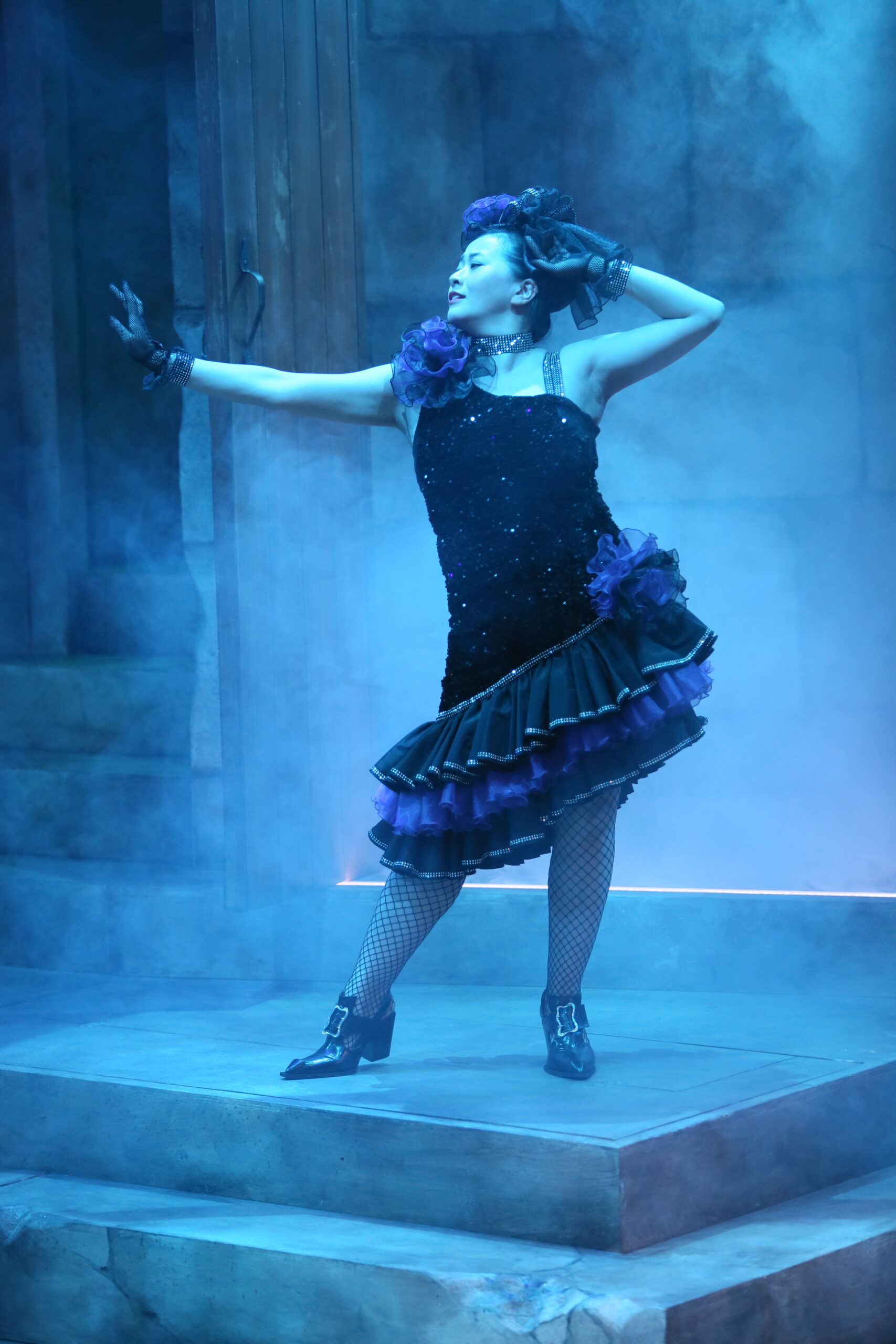There are few theatrical effects as impactful as a well-placed fog machine—think, for example, of the plume of fog that accompanies Julius Caesar’s entrance, when the ghost of the late Roman statesman returns to haunt Brutus in Cherissa Richards’ Julius Caesar (2023). Or, if you’ve seen Measure for Measure on the Howard Family Stage this Season, you might have noticed how the production uses haze to bring you into the pulsing world of a Vienna that never sleeps.
But have you ever wondered how—and why—theatres like Bard use fog and haze in their productions? We spoke with Bard Production Director Jonathan Ryder and Lighting Designer Hina Nishioka (The Comedy of Errors and Measure for Measure) to clear the air about some common misconceptions regarding fog and haze—and to learn more about how atmospheric effects can be used to bring these stories to life.

Leslie Dos Remedios as Mariana in Measure for Measure (2024) | Directed by Jivesh Parasram | Set Design by Ryan Cormack | Costume Design by Alaia Hamer | Choreography by Krystal Kiran | Lighting Design by Hina Nishioka | Photo by Tim Matheson.
The most common misconception about atmospheric effects is that what you’re seeing on stage is smoke. Fog machines and hazers actually use a water-based fluid, which is vaporized to create the atmospheric effects seen in our productions. Unlike smoke, the fog and haze that is produced is non-toxic and complies with safe workplace practices for our performers and crew.
“We are very conscious that our actors perform their roles on stages in tents with fluctuating temperatures and humidity over a long season,” says Production Director Jonathan Ryder. “We cannot put anything in the air they breathe which could be detrimental to their voices, and this includes the use of fog and haze for special effects.”
There are no health dangers posed by the fog and haze used on stage, but we also understand that these atmospheric effects may create discomfort, whether it’s from the lack of visibility or the smell of the materials being used. Many hours of our technical rehearsals are spent adjusting the balance of fog and haze to achieve the effects intended by our designers, while also considering the comfort of our Company and audience members. With our productions taking place in tents, it can be a challenge to recreate the balance and aesthetic of these atmospheric effects day after day, but it’s something that our venue technicians and technical team continue to monitor throughout the Season.
“Temperature, barometric pressure, and humidity all influence [these effects], so some days the intensity or distribution of fog or haze may be different or more concentrated than other days,” says Jonathan. “Whenever we get a comment about fog or haze, we always check with the crew to see how this compares to their notes about the performance. In most cases, we noticed something was different that day and will likely have already adjusted for future shows.”
With all these challenges, why use fog and haze at all?
We’ve mentioned how visually impactful fog can be. The thick, opaque fog clouds can create memorable character entrances or add stunning atmospheric effects that emphasize the story, themes, and world of the production. Fog also dissipates within minutes, meaning it can be used for maximum impact without affecting any subsequent scenes on stage. As an example of how and why we use fog, Lighting Designer Hina Nishioka mentions how “the fog in Abhorson’s entrance [in Measure for Measure] plays a significant role in supporting how ridiculous his entrance is.”
Haze, on the other hand, creates a more subtle, consistent mist that hangs in the air for longer than fog. It can help amplify lighting effects, bringing out lighting beams that you might not be able to see otherwise, while also adding another perspective to the textures and colours on stage. “The haze adds a mask of a ‘throwback memory’ look,” Hina tells us. “It’s as if we’re seeing a photo from the past year vs. a photo from the 2000s.” And just like fog, haze can also be used to highlight the tone, themes, and setting of a production.
“In The Comedy of Errors, a thin layer of haze supports [the play’s setting of an] oceanside town where water in the air evaporates from the summer heat in the Mediterranean,” says Hina. “As the play develops, the haze will also act as the dust from the dry soil on the ground… as well as a (metaphorical) veil that surrounds the town of Ephesus, which Antipholus and Dromio of Syracuse find weird.”
In contrast, Hina tells us, “the haze and fog [in Measure for Measure] plays a significant role in bringing the audience into its disco world. Haze is used to create the rave [on the dance floor], the smoky office inside a music venue, and the hazy morning/night in Vienna. The most important part of having haze in Measure for Measure was so the audience could see the lighting beams, especially in dance scenes—not just from the moving lights, but also from the reflections from Aux Cable’s helmet and the mirror ball!”
Thanks so much to Jonathan and Hina for chatting and sharing these insights with us today! We’re so grateful for all the hard work that goes on behind the scenes to bring us the shows you see on stage. If you haven’t already, be sure to get your tickets for our 2024 Season by visiting our Season Schedule.
